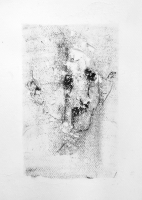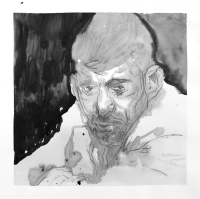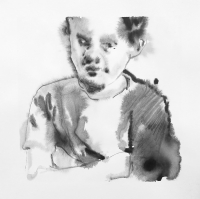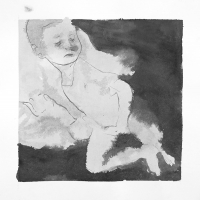Mišo Ormos - Utečenci
Mišo Ormos - Refugees
curator: Zuzana Danková
8.6. - 2.7. 2016
DOT. Contemporary Art Gallery, Bratislava, Slovakia
SK
Ormošova tvorba sa priamočiaro uberá k témam efemérnosti, nestálosti, pominuteľnosti, ale aj existencializmu, ktoré autor programovo opakovane spracováva, často vo veľkom počte diel (napríklad série Pope a Blues).
V súčasnosti svojou tvorbou (v typicky pochmúrnej čierno-bielej farebnosti a zameraní sa na portrét a figúru) Ormoš reaguje na aktuálnu situáciu vo svete: téma utečencov je od konca minulého roka mimoriadne exponovaná, medializovaná, rôzne interpretovaná a často v deformovanej podobe predkladaná slovenskému čitateľovi alebo divákovi. Záplavy správ neobišli ani autora, ktorý toto množstvo informácií ako príjemca už nedokáže prijímať a začína byť voči tejto chúlostivej téme rovnako, ako mnohí iní, apatický alebo rezistentný.
Ormoš si všíma našu častú tendenciu sympatizovať s jediným druhom správ, fotografií či názorov, namiesto analýzy a vyhodnocovania veľkého množstva rozličných dostupných informácii, a zároveň tendenciu zovšeobecňovania, neschopnosti zaostriť svoju pozornosť na detaily a konkrétnosti. Vychádzajúc z týchto postrehov volí autor jednoduchý postup, výtvarné gesto, pri ktorom sa z množstva spravodajských fotografií, často zobrazujúcich davové scény,
zameriava na jednotlivca, ku ktorému smeruje svoju pozornosť. Týmto jednoduchým, ale účinným gestom poukazuje na nerovnorodosť masy: dav už nie je anonymný, jednotný a neuchopiteľný, tvoria ho portréty jednotlivcov, ktoré však v inštalácii na stenách galérie môžu opätovne evokovať nerozlíšený, jednotvárny celok. Jednotlivé diela pritom netreba vnímať ako osobnostné portréty konkrétnych ľudí, ale skôr portréty osudov a situácií, komunikujúce s nami vlastným emocionálnym jazykom – výtvarnou vizualitou.
Keďže téma migrácie nie je ani v našom geografickom, historickom a umeleckom kontexte nová, skôr sa len vrátila v obmenenej podobe a kvôli iným príčinám a konfliktom, spracovaniu témy predchádzal aj jej rešerš v dejinách slovenského výtvarného umenia (napríklad Majerník, Hložník, Špitz). Rovnako ako v súvislosti s dielami C. Majerníka, by vety Zsófie Kiss Szemán priliehavo vypovedali aj o aktuálnych obrazoch Ormošových Utečencov : “Zástupy ľudí vyhnaných z domova tvoria nekonečný prúd, primpomínajúci hrču špinavých handier. S batohmi na chrbte nútene pochodujú do neznáma, do neistoty.”
Ormošové obrazy pôsobia niekedy ako vypetá situácia, inokedy ako čakanie. Raz pôsobí kresba ako obraz dovolenky, inokedy ako biblický alegorický výjav. Tento dojem nie je náhodný a vytvára ho práve nezvyčajnosť portrétovania existenciálnej témy v kombinácii s nedeskriptívnou graficky pôsobiacou technikou a výrazovou skratkou (tuš, voda, rytie) s prenikavým expresívnym nábojom.
Kresby významovo dopĺňa Inštalácia 88, rytmický dav – syndróm idealizovanej EÚ: na jednej strane naoko krásni ľudia a ich vrúcne pozdravy, na druhej – vítanie hajlovaním, ako nenávistné gesto.
Zuzana Danková
EN
Ormoš’s work heads directly into the themes of ephemerality, instability, finiteness altogether with existentialism. All of them are programmatically and repeatedly processed in the high number of author’s artefacts (e.g. Pope and Blues series).
In his current work (using his typically bleak black-and-white colours and a focus on a portrait and a figure), Ormoš reacts to actual situation in the world: the subject of refugees has been strikingly exposed and publicized since the end of the last year, variously interpreted and often presented in a deformed shape to Slovak readers and viewers. Under this flood of information, our author loses the receiving quality, beginning (as many others) to be apathetic and resistant towards the sensitive topic.
Ormoš notices our common tendency to sympathize with one kind of news, photographs or opinions without an analysis and evaluation of higher amount of various accessible pieces of information, both with a tendency for overgeneralization; our inability to focus an attention on details and concreteness. Building on the basis of these observations, the author chooses a simple approach – in his art gesture, he works with a high amount of photographs picturing crowd scenes, where he highlights an individual, towards whom his attention is driven. By this simplistic, but an effective gesture, Ormoš shows a heterogeneity of a mass: a crowd is no longer anonymous, uniform and incomprehensible; now it consists from portraits of individuals, though it might once again evoke a non-distinguished, homogeneous unit, when being installed on the walls of the gallery. However, his works should not be perceived as personality portraits of particular people, but more as portraits of destinies and situations, communicating with us by their own emotional language – the art visualisation.
As a topic of migration is not that new in our geographic, historical and artistic context (it has just returned in a different shape and due to slightly different reasons and conflicts than those before), a research of the topic within the history of the Slovak art (e.g. Majerník, Hložník, Špitz) had been done before its artistic processing. Similarly as in their connection with the works of C. Majerník, the sentences of Zsóffia Kiss Szemán could be used as a precise comment on the actual paintings of Ormoš’s Refugees (Utečenci): “The crowds of the people that have been cast out of their homes form an infinite flow, resembling a cluster of dirty rags. With the packs on their backs, they are forced to march towards unknown, towards uncertainty.”
Ormoš’s paintings once seem to depict tense situations, once a waiting. One time, a particular drawing acts as an image of the vacancy, other time as a biblical, allegorical scene. Such impression is not accidental; it is achieved by the unusualness of the way of portrait creation by combining an existential theme with non-descriptive, graphically-acting technique and a shorthand procedure (ink, water and engraving) with a vivid expressionistic quality.
The drawings are semantically coexisting with Installation 88 (Inštalácia 88) that depicts a rhythmic crowd – a syndrome of the idealised EU: on one side seemingly beautiful people and their fervent greetings, on the other one – greetings of hailing as a gesture of hatred.
Zuzana Danková












































